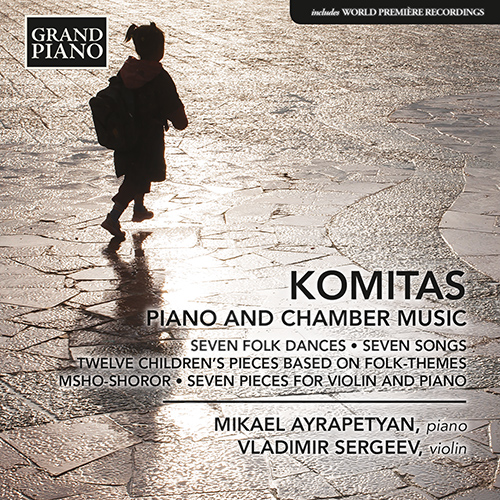
About this Release
“Armenia - my native country. For me, the popularization of Armenian classical music is a vital priority. A huge volume of Armenian classical music remains unknown to the world, which must be discovered. Art should not remain in oblivion!” — Mikael Ayrapetyan
KOMITAS (1869–1935)
Piano and Chamber Music
Seven Folk Dances • Seven Songs • Twelve Children’s Pieces Based on Folk-Themes • Msho-Shoror • Seven Pieces for Violin and Piano
- Mikael Ayrapetyan, piano
Komitas was one of the first Armenian musicians to undergo classical Western musical training, in Berlin, in addition to music education in his own country. He published both folksong collections and writings on Armenian church melodies, and his work laid the foundations for the development of a clearly defined national musical style. The Seven Folk Dances evoke the specific timbres of Armenian instruments, the Seven Songs for Piano are fleeting and lyrical while the Twelve Children’s Pieces based on folk-themes are beautifully crisp. Msho-Shoror is one of the most ancient of all Armenian dances.
Tracklist
|
7 Folk Dances () (00:17:00 )
|
|
1
No. 1. Manushaki of Vagharshapat (00:03:14)
|
|
2
No. 2. Yerangi of Yerevan (00:03:57)
|
|
3
No. 3. Unabi of Shushi. No. 4. Marali of Shushi (00:04:25)
|
|
4
No. 5. Shushiki of Vagharshapat (00:03:37)
|
|
5
No. 6. Het u Aradj of Karin (00:02:52)
|
|
6
No. 7. Shoror of Karin (00:05:08)
|
|
7 Songs for Piano () (00:07:20 )
|
|
7
No. 1. Es Ahchikem (I'm a Girl) * (00:01:00)
|
|
8
No. 2. Ervum em (I'm Burning) * (00:00:45)
|
|
9
No. 3. Tun ari (Come Home Again) * (00:01:06)
|
|
10
No. 4. Gutan'e hats em berum (Bread I Carry for the Ploughman) * (00:01:00)
|
|
11
No. 5. Lusnak'e sari takin (The Moon under the Mountain) * (00:01:23)
|
|
12
No. 6. Es Gisher, lusnak Gisher (This Night, the Moonlit Night) * (00:01:24)
|
|
13
No. 7. Gzhur kuga verin Sarin (Water Flowing from the High Mountain) * (00:00:31)
|
|
12 Pieces for Children () (00:11:00 )
|
|
14
No. 1. Andzev ekav (Rain Has Come) (00:00:37)
|
|
15
No. 2. Andzev ekav (Rain Has Come) Variation (00:00:34)
|
|
16
No. 3. Phapuri (Pchapuri) (00:00:29)
|
|
17
No. 4. Gzhur kuga verin Sarin (Water Flowing from the High Mountain) (00:00:41)
|
|
18
No. 5. Yar jan u Marjan (My Darling and Marjan) (00:00:56)
|
|
19
No. 6. Yar jan u Marjan (My Darling and Marjan) Variation (00:01:19)
|
|
20
No. 7. Es Ahchikem (I'm a Girl) (00:00:39)
|
|
21
No. 8. Haralo (Kharalo) (00:01:37)
|
|
22
No. 9. Sar, Sar (The Mountain, The Mountain) (00:00:42)
|
|
23
No. 10. Sar, Sar (The Mountain, The Mountain) Variation (00:00:43)
|
|
24
No. 11. Arev, Arev (The Sun, the Sun) (00:00:41)
|
|
25
No. 12. Pies Zhohovrdakan Hokov (Piece in the National Spirit) (00:02:00)
|
|
26
Msho-Shoror () (00:07:57)
|
|
27
Chinar Es (You Are a Tree) (arr. A. Gabrielian for violin and piano) (1906) * (00:02:31)
|
|
28
Al Aylukhs (The Scarlet Shawl) (arr. A. Gabrielian for violin and piano) (1911) * (00:01:53)
|
|
29
Dsirani dsaṙ (Tsirani Tsar, The Apricot Tree) (arr. A. Gabrielian for violin and piano) (1906) (00:03:44)
|
|
30
Akh, Maral djan (Ah, Sweet Maral) (arr. A. Shamschian for violin and piano) (1899) * (00:03:17)
|
|
31
K'eler, tsoler (Keler, tsoler, He Walked, Shining) (arr. K. Dombaev for violin and piano) (1911) * (00:03:45)
|
|
32
Kṙunk (Krounk, The Crane) (arr. S.Z. Aslamazian for violin and piano) (1911) (00:04:34)
|
|
33
Kak'avi erg (Kagavik, The Song of the Partridge) (arr. A. Gabrielian for violin and piano) (1908) * (00:01:46)
|
The Artist(s)
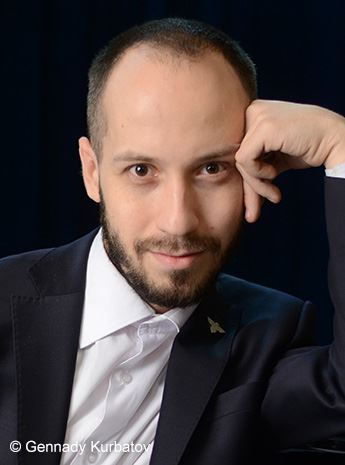 Mikael Ayrapetyan is a pianist, composer, producer and teacher, as well as a researcher and public figure. He has done much to popularise Armenian classical music all over the world with his Secrets of Armenia musical project, which began during his studies at the Moscow Conservatory. Born in 1984 in Yerevan, Armenia, he studied at the Moscow Tchaikovsky State Conservatory, and continues to uphold the performing traditions of the Russian piano school, of which Konstantin Igumnov, Samuel Feinberg and Lev Oborin are luminaries. His repertoire ranges from the Baroque to the contemporary and includes rarely performed works by Armenian composers. This period was the start of his extensive concert activity in which he performs works by Tigranian, Chukhadjian, Komitas, Melikian, Spendiarian, Barkhudarian, Stepanian, Khachaturian, Babajanian, Arutyunian, Abrahamian, Bagdasarian, Avetisian, Mirzoyan, Amirkhanian and many other Armenian composers, which eventually led him to produce his own concerts. He was awarded the State Prize of the Republic of Armenia for his outstanding contribution to the development and popularisation of Armenian classical music.
Mikael Ayrapetyan is a pianist, composer, producer and teacher, as well as a researcher and public figure. He has done much to popularise Armenian classical music all over the world with his Secrets of Armenia musical project, which began during his studies at the Moscow Conservatory. Born in 1984 in Yerevan, Armenia, he studied at the Moscow Tchaikovsky State Conservatory, and continues to uphold the performing traditions of the Russian piano school, of which Konstantin Igumnov, Samuel Feinberg and Lev Oborin are luminaries. His repertoire ranges from the Baroque to the contemporary and includes rarely performed works by Armenian composers. This period was the start of his extensive concert activity in which he performs works by Tigranian, Chukhadjian, Komitas, Melikian, Spendiarian, Barkhudarian, Stepanian, Khachaturian, Babajanian, Arutyunian, Abrahamian, Bagdasarian, Avetisian, Mirzoyan, Amirkhanian and many other Armenian composers, which eventually led him to produce his own concerts. He was awarded the State Prize of the Republic of Armenia for his outstanding contribution to the development and popularisation of Armenian classical music. The Composer(s)
 Komitas was one of the first Armenian musicians to undergo classical Western musical training, in Berlin, in addition to music education in his own country. He was educated in a theological seminary in Vagharshapat, and ordained a priest in 1894. A gifted singer, he studied liturgical singing and early Armenian chant notation. He also developed a keen interest in folksong, and collected melodies which he would then harmonise for choral performance. He published both folksong collections and writings on Armenian church melodies, and his work laid the foundations for the development of a clearly defined national musical style. He moved to Constantinople in 1910, a city with a significant Armenian population, and continued to compose (predominantly vocal music), conduct and research.
Komitas was one of the first Armenian musicians to undergo classical Western musical training, in Berlin, in addition to music education in his own country. He was educated in a theological seminary in Vagharshapat, and ordained a priest in 1894. A gifted singer, he studied liturgical singing and early Armenian chant notation. He also developed a keen interest in folksong, and collected melodies which he would then harmonise for choral performance. He published both folksong collections and writings on Armenian church melodies, and his work laid the foundations for the development of a clearly defined national musical style. He moved to Constantinople in 1910, a city with a significant Armenian population, and continued to compose (predominantly vocal music), conduct and research. Reviews
“These pieces are graciously and sensitively performed, and well recorded.” – Fanfare
“I strongly recommend exploration of this illuminating and beautifully recorded disc.” – MusicWeb International
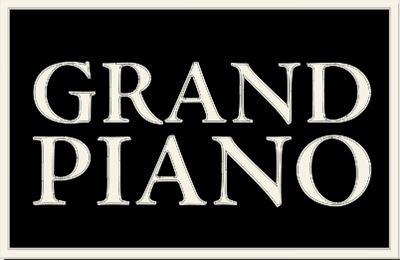
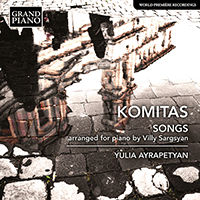
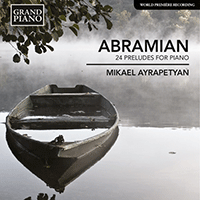
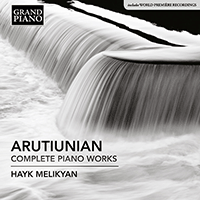
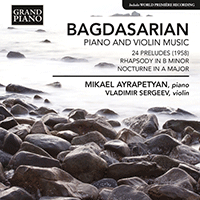
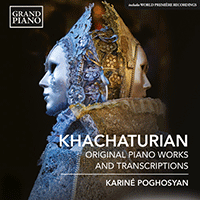
 Grand Piano has gained a reputation for producing high quality recordings of rare keyboard gems. Dedicated to the exploration of undiscovered piano repertoire, the label specialises in complete cycles of piano works by many lesser-known composers, whose output might otherwise have remained unknown and unrecorded.
Grand Piano has gained a reputation for producing high quality recordings of rare keyboard gems. Dedicated to the exploration of undiscovered piano repertoire, the label specialises in complete cycles of piano works by many lesser-known composers, whose output might otherwise have remained unknown and unrecorded.






